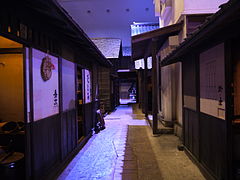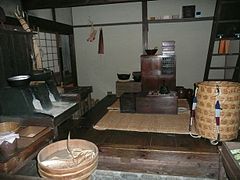Fukagawa Edo Museum
The Fukagawa Edo Museum ( Japanese 深 川江 戸 資料 館 , Fukagawa Edo shiryōkan ) is a small museum of local history in Tokyo that is supported by the district of Kōtō .
The centerpiece of the museum, which was opened in 1981 and renovated in 2010/11, is the 1: 1 replica of a typical Tokyo district from the first half of the 19th century. Fukugawa, on the banks of the Sumida River, was a world of its own with very mixed occupations. There were fishermen, greengrocers, oil wholesalers, but also teachers for recitation singing ( 長 唄 ), but above all the kimpi ( 金 steller ) manufacturers, who mainly made and sold dried fish scraps and fertilizer from hoshika ( 干 鰯 ) .
Visitors to the museum can walk through the reconstructed alleyways, in which, among other things, a fireproof store (kura) and a lookout (yagura) for the discovery of fires have been built. In addition to a narrow row of houses (nagaya) with the tiny accommodations of the poor people, the museum also houses a canal where a suitable boat, a chokibune ( 猪 牙 舟 ), lies at the pier. A tavern complements the ensemble.
The much larger Edo Tōkyō Museum later adopted this presentation idea with the replica of the Nihonbashi within the museum. There the reconstruction of an old district of Tokyo is part of the concept, here the idea is the focus.
The museum also has a small theater room with 300 seats, which as a kind of yose ( 寄 席 ) is well suited for the performance of traditional music, dances or rakugo .
literature
- Museum leaflet
- Tokyo-to rekishi kyoiku kenkyukai (ed.): Tokyo-to no rekishi sanpo (jo) . Yamakawa, 2001. ISBN 4-634-29130-4 .
Web link
Coordinates: 35 ° 40 ′ 51.9 ″ N , 139 ° 48 ′ 1.7 ″ E





